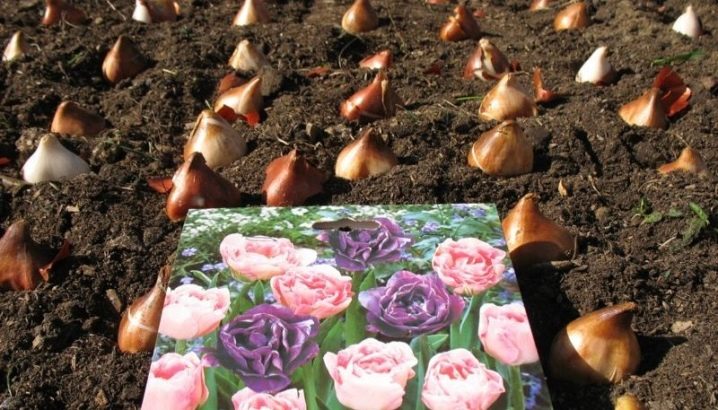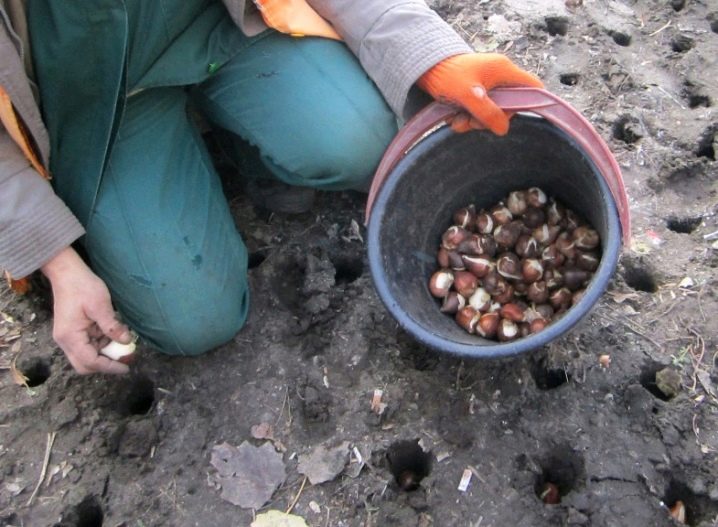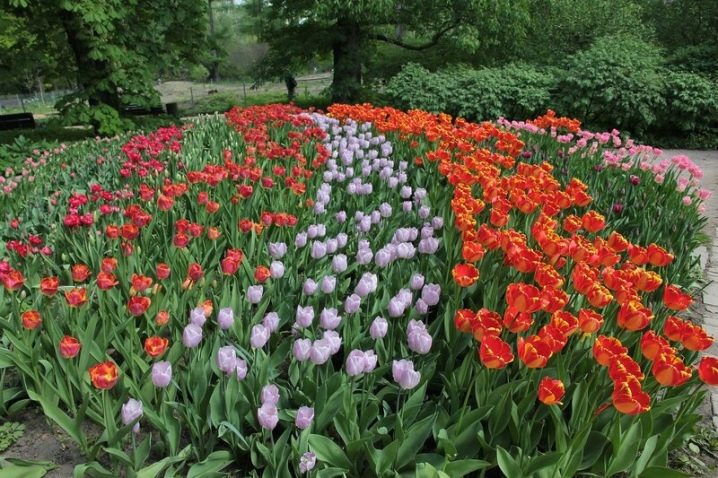When and how to plant tulips correctly?

Tulips are always associated with March 8, spring and the awakening of nature. They are among the first to bloom in spring, delighting with their bright and colorful flowering. But in order for this non-capricious and beautiful flower to bloom in time, you must first of all plant it correctly.

Landing dates
The peculiarity of tulips that distinguishes it from many other flowering plants is that the best time to plant it is autumn. One of the conditions for the active spring growth of tulips is the need to cool the bulbs, which occurs naturally during their wintering in the soil.
With the onset of autumn, nature falls asleep and it is time for rest, but tulip bulbs planted in the soil awaken and become more active. At this time, they form the root system, gaining a supply of nutrients for the future spring development of leaves and flowers.
Tulips need about 4-6 weeks to take root. Therefore, it is so important to correctly determine the timing of their planting. With a belated planting, the growing roots may suffer or completely die from frost. This will be reflected in the spring development and flowering of the plant. In addition, these tulips are weaker and prone to disease.

Tulips planted too early can start the green mass growth process prematurely. Such untimely planting can lead to either late and poor flowering, or to the death of flowers.
The time range for planting tulips is quite wide and directly depends on the geographical location of the region. Planting time is from August to October. However, a general condition to be observed is the optimum soil temperature. You can plant bulbs if the soil warms up from +8 to +10 degrees to a 15-centimeter depth. This guarantees good growth and development of tulips in the future.

Depending on the region
When planting tulips in autumn, it is necessary to take into account the varied climatic conditions of certain regions. In addition, the annual climatic seasonal changes are also different - sometimes warmer, sometimes colder. This also needs to be taken into account.
For central Russia, including the Moscow region, the optimal time for planting tulips is from the beginning of September to the end of October. This time is usually characterized by still rather warm weather with periodic rains, and frosts are possible only in late September - early October.
At a daytime temperature of +3 - +10 degrees, the bulbs actively take root, which tolerate night temperatures well up to +3 degrees. Usually, such a temperature regime in the middle lane occurs from September 20th to mid-October.

For regions with colder climates, planting dates are somewhat different. In Siberia, frosts come much earlier, and short autumn is most often cold and rainy. Therefore, here the period of planting bulbs begins in the 3rd decade or at the very end of August and lasts until the first days of September. In a warm autumn, they can be planted throughout the first half of September.
In the Urals, the climate is milder, but the planting of bulbs is also carried out in accordance with the weather. In the regions of the Northern Urals, it is recommended to plant tulips from late August to mid-September. In the middle Urals, planting dates increase until the beginning of the third decade of September, and in the south of the region, it is possible to plant bulbs from the first days of September until the end of the first decade of October.
Kuban is characterized by mild and warm winters and dry autumn. The landing dates are slightly different here. The best time comes from the first days to the end of October. The same time frames are also suitable for the Crimea and the Stavropol Territory.

Lunar calendar
Many gardeners plant cultivated plants, including flowers, adhering to the lunar calendar. According to such a calendar, one or another crop can be planted on certain days, and they are different in each month.
For tulips and other bulbs, the days of the Taurus sign are considered the most favorable for planting. These tulips are distinguished by the duration of flowering and the beauty of the flowers. You can also plant them on Libra days.
It is not recommended to plant bulbs on the days of the Cancer sign (the frost resistance of flowers may decrease) and on the days of Pisces (tulips may rot).

Preparation
An important step in tulip cultivation is preparation for planting. It includes several important points.
Seat selection
Tulips love bright sunlight, so this should be taken into account when choosing a place to plant it. A flower garden for tulips should not only be well lit, but also located in places inaccessible to drafts and cold winds. Sites that are flat or with a slight elevation or slope, where water does not stagnate, are best suited.
It is not recommended to plant tulip bulbs near buildings, as they will shade the flower garden. This will negatively affect the appearance of the flowers. Tulips planted in groups look much more impressive than single plantings. In a limited area of the site, tulips can be planted next to vegetables. They will look good against a green background of root parsley or carrots.

It is also important not only the location of the flower garden, but also the selection of other flowers adjacent to the tulips.
Tulips, planted next to daffodils, hyacinths, stand out beautifully and vividly. To hide tulip leaves drying out after flowering, it is recommended to plant them next to other perennials with lush foliage. In flower beds with several tiers, tulips are planted in the far or middle row. Lush perennials (hostu, different types of fern, phlox) are planted near them. The foreground can be filled with primroses along with carnations and bells.

Bulbs
The processing of the bulbs is also important. When, after flowering, most of the leaves (about 2/3) of tulips dry up, they are dug out. It is better to do this in sunny, not rainy weather. The bulbs are cleaned of soil and carefully examined. Damaged bulbs with cuts or signs of decay are discarded.
Then the planting material is laid out in one layer in containers for drying and placed in a shady place with good aeration. Covering the onions is not recommended. From time to time they need to be examined and discarded if found soft, moldy or stained. During storage, these conditions must be observed.
The room where tulips are stored must be dry and well ventilated. At high humidity, fungal diseases can develop in the bulbs. At the same time, in very dry air, they can dry out and die.
At first, the seed should be stored at a temperature of + 23- + 25 degrees. In August, they are placed in a cooler room with a temperature of about +20 degrees. A week before planting, they are already stored at +15.

Tulips are prepared for planting in this way:
- all dry husks are removed from the bulbs;
- only healthy specimens are selected without damage and signs of disease;
- distribute the bulbs by size.

Before planting, tulips must be treated with agents to prevent the occurrence of fungal infections and harmful insects, and it is also beneficial to treat them with drugs that stimulate plant growth. The following drugs are used:
- fungicide "Vitaros" and biofungicide "Fitosporin" - they are sprayed with planting material before planting;
- fungicide "Maxim" - the bulbs are placed in the solution before planting for 30 minutes;
- the drug "Epin", stimulating growth - the bulbs are soaked and kept in it for a day.
You can also use other fungicides - "Agat", "Albit", "Skor".

Priming
Tulips prefer a fairly nutritious, loose soil that is well permeable to water and air. In order for the flowers to develop well and fully, it is necessary that the fertile layer be at least 40 cm. Organic (compost, ash and humus) and inorganic fertilizers improve the soil fertility.
Sandy soil, which is characterized by low fertility and rapid drying, requires constant fertilizing and watering. A similar soil is fertilized with the following composition: ash (about 200 g), compost (2 buckets), saltpeter (about 25 g), potassium sulfate (30 g) and superphosphate (about 50 g). With a high acidity of the soil, it is necessary to add chalk or slaked lime (200-500 g per 1 sq. M.) To it.
Dense clay soil can be made looser if peat and sand are added to it during digging at the rate of 5 kg per 1 sq. m. The addition of ash is effective, which is not only a fertilizer, but also a protection against diseases.
They begin to prepare the soil in advance, about a month in advance. It is dug up and organic matter (humus, compost, ash) and mineral fertilizers (saltpeter, superphosphate) are introduced. Fresh manure cannot be used, as it can harm the bulbous roots. If the soil has time to dry, it is first watered well with water, and after 1-2 days it is dug up.

Before planting the bulbs, the flower garden is watered with a weak solution of potassium permanganate or fungicide to disinfect the soil from harmful infections.
How to plant?
After carrying out all the preparatory measures, you can plant tulips in open ground in flower beds previously prepared on the site. Do not keep unprocessed bulbs for a long time, as they can swell, and this will reduce the germination of tulips.
In the flowerbed, grooves or holes are made with a depth of about 10-15 cm. If the soil is light, then the onions deepen more. In addition, the planting depth depends on the size and variety of tulips: the largest specimens should be planted to a depth of 15 to 18 cm. Medium-sized bulbs are deepened by 10-12 cm, and children are planted at a shallow depth of 4-10 cm.
The spaces between the onions are approximately 10-15 cm. Small bulbs are planted closer. The distance between the rows should be between 20 and 30 cm.
If there is a risk of stagnation of water in the ground, then a drainage layer of 1-2 cm from expanded clay, pebbles, sand is placed in the grooves.
The grooves need to be well watered with settled cold water, then the onions are placed in them with the lower root part. This must be done carefully, you cannot press hard on the bulbs so as not to damage the roots. Then they are sprinkled with ash and covered with soil. The land at the landing site is well leveled so that water does not stagnate.

The largest bulbs are recommended to be planted in the center of the flower garden, the smaller ones around. This planting will prevent tall flowers from obscuring the lower ones and ensures uniform flowering.
Currently, the widespread method of growing tulips in containers or in any other container. Special plastic baskets for bulbous plants are used as containers for planting. You can also use low vegetable boxes and other containers, as long as they have holes in the bottom.
The advantages of this method are as follows:
planted tulips are easily dug out for transplanting; for this, the container is simply removed;
only the container is filled with soil mixture, and there is no need to dig up and fertilize a large area for a flower bed;
in containers, the bulbs are not lost or damaged when removed;
in such containers, tulips can be grown on the balcony.


The containers are filled with ready-to-use purchased substrate. You can also prepare potting mix at home. Properly formulated soil includes the following components: garden soil, humus, sand, vermiculite and perlite based on coconut fiber.
On the site, they outline the landing sites for tulips, dig out recesses corresponding to the size of the container, where they are placed. The bottom of the container is covered with sand, and then the onions are planted at a distance of 4 to 15 cm, depending on their size and variety. After that, the container is covered with soil, and on top is covered with a layer of mulch (humus, peat) of 1-2 cm.
Experienced flower growers plant tulips at a depth of 3 times the height of the onion. This ensures fast germination of the flower. Also, when landing, it is necessary to take into account the following points:
in light soil, the onions are planted deeper than usual, by 2-3 cm, and in clay soil, on the contrary, on a smaller one, also by 2-3 cm;
it is not recommended to plant tulips very deeply, as in this case the flower will have very few children;
if planted too close to the surface, tulips can freeze in winter.

It is common to plant tulips in the fall. However, it is possible to do this in the spring as well. It should be borne in mind that spring tulips are much weaker than autumn ones, they bloom very late or do not bloom at all... The reason is that it is the air temperature that determines the timing of the blooming of tulips. In warm weather, they do not form buds, since the plant did not have time to fully develop.
If you plan to plant flowers in the spring, then the bulbs must be properly prepared for winter storage. Dug out and selected healthy tulips are disinfected with a solution of (weak) potassium permanganate for the prevention of diseases and the occurrence of rot.
Then the onions are dried and placed in containers filled with sawdust. Store in a cool dry (with a temperature of about 0) and well-ventilated place. This is usually a basement or cellar.

To properly carry out a spring planting, you need to know some of the nuances.
It is important to determine the time frame correctly. The plant needs the earliest possible planting. They are planted as soon as the weather is stable. In some areas this is possible as early as February, but they are usually planted between March and early April.
To protect tulips from frost, they can first be planted in containers, and then transferred to a flower bed with warming.
Site selection and soil preparation the same as for the autumn landing. In the same way, you need to select and prepare the onions for planting.
A prerequisite for spring disembarkation is the need for pre-cooling tulips. To do this, they are kept in the refrigerator for 12 hours.
Planting is done only in warm soil. It should warm up to a depth of disembarkation (10-15 cm) up to about +9 degrees.


In spring, flowers require a slightly higher amount of fertilizer. This is due to their active spring growth and better absorption of nutrients. The first time they are fed with mineral fertilizers some time after planting.
Further care
Correctly planted tulips will fully adapt after about a month and form strong and healthy roots. Flowers are ready to survive the winter successfully. Immediately after planting, tulips do not need to be watered. Only in dry weather do they need watering, but not earlier than 10 days after planting. Watering can be combined with fertilizing with saltpeter.
To protect the bulbs from frost, they are covered with mulch (5 cm layer) - straw, leaves, peat. And in winter, snow protects tulips from frost. In addition, it protects the soil from cracking, which is dangerous for the root system of the plant. In spring, when the snow melts, it enriches the soil with moisture. After the snow melts, the mulch is removed so that the flowers develop more actively.

Further care for tulips is as follows.
Watering should be abundant during the formation and development of buds, then during their active flowering. This watering is continued for about 2 weeks after flowering.
Systematic weeding of the soil is carried out. Simultaneously with the removal of weeds, the soil near the plants is loosened.
- Fertilize regularly. You can feed the flowers either liquid or dry, in the form of granules, with mineral fertilizers. During the growing season, tulips are fed three times. The first feeding is done during the appearance of the first shoots with such a composition - nitrogen (2 parts), phosphorus (2 parts) and potash (1 part) fertilizers. The second time - during the formation of a still green bud and use a mixture of nitrogen (1 part), phosphorus and potassium (2 parts each) fertilizers. The third time - immediately after the end of flowering, only phosphorus and potassium fertilizers are applied without nitrogen.


It is also important to cut off wilted flowering flowers. This has a beneficial effect on the formation of quality bulbs.
Experienced flower growers advise replanting tulips annually.... This will preserve the size of the buds and the variety of flowers.
Cultivation of tulips is a rewarding business if you adhere to all the rules for planting and growing them. Varietal variety allows you to grow from them variegated, bright and colorful flower gardens and flower beds, which are a real decoration of the site.

For information on how to plant tulips correctly, see the next video.







































































































Thanks! Everything is clear, clear and understandable. Found everything I was looking for.
The comment was sent successfully.